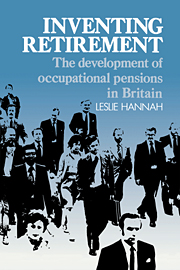Book contents
- Frontmatter
- Contents
- List of tables and figures
- Preface
- Part I The rise of pensioning
- 1 Savings, work and old age in Victorian Britain
- 2 Rival pioneers of collectivism: pensions, the state and employers (1899–1927)
- 3 The insurance challenge (1927–56)
- 4 The state: partner or competitor? (1940–78)
- 5 Competition and professionalization: the maturing of the pension market (1956–79)
- Part II The shaping of the modern pensions institution
- Epilogue: Contemporary critics and the future of pensions
- Statistical appendix
- A note on sources
- Notes
- Index
4 - The state: partner or competitor? (1940–78)
Published online by Cambridge University Press: 03 May 2010
- Frontmatter
- Contents
- List of tables and figures
- Preface
- Part I The rise of pensioning
- 1 Savings, work and old age in Victorian Britain
- 2 Rival pioneers of collectivism: pensions, the state and employers (1899–1927)
- 3 The insurance challenge (1927–56)
- 4 The state: partner or competitor? (1940–78)
- 5 Competition and professionalization: the maturing of the pension market (1956–79)
- Part II The shaping of the modern pensions institution
- Epilogue: Contemporary critics and the future of pensions
- Statistical appendix
- A note on sources
- Notes
- Index
Summary
The fundamental question is whether we are to regard the State as partner or competitor. For my part I still cling to my original opinion that this package of legislation provided and continues to provide a springboard for new business.
Legal & General manager, staff Annual Conference, privately printed, 1963, p. 73Until the twentieth century was well advanced, British government departments knew very little (and, in general, did not want to know more) about occupational pension schemes. Early proposals to undertake a survey of private sector pension schemes were for nearly three decades shunted from ministry to ministry until finally the Ministry of Labour undertook the first comprehensive survey in 1936. The concerns of the Government Actuary's Department (established in 1919) were mainly confined to national insurance matters and public sector pensions. Pension schemes were, of course, affected by legislation, but its impact for the first four decades of the century had been slight. The 1927 Validation Act, for example, brought several hundred funds into the purview of the Registrar of Friendly Societies, when they wished exemption from the law against perpetuities. Parliament laid down certain minimal conditions for such approval: for example, that registered pension funds could not invest in the employing firm unless the loan were properly secured and the firm had a good dividend record. Most funds did not, however, bother to register, and lawyers devised other, simpler means of avoiding the law against perpetuities, advising that by the time any disadvantages emerged, the law would be changed.
- Type
- Chapter
- Information
- Inventing RetirementThe Development of Occupational Pensions in Britain, pp. 46 - 64Publisher: Cambridge University PressPrint publication year: 1986



